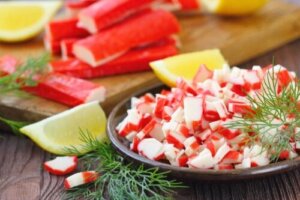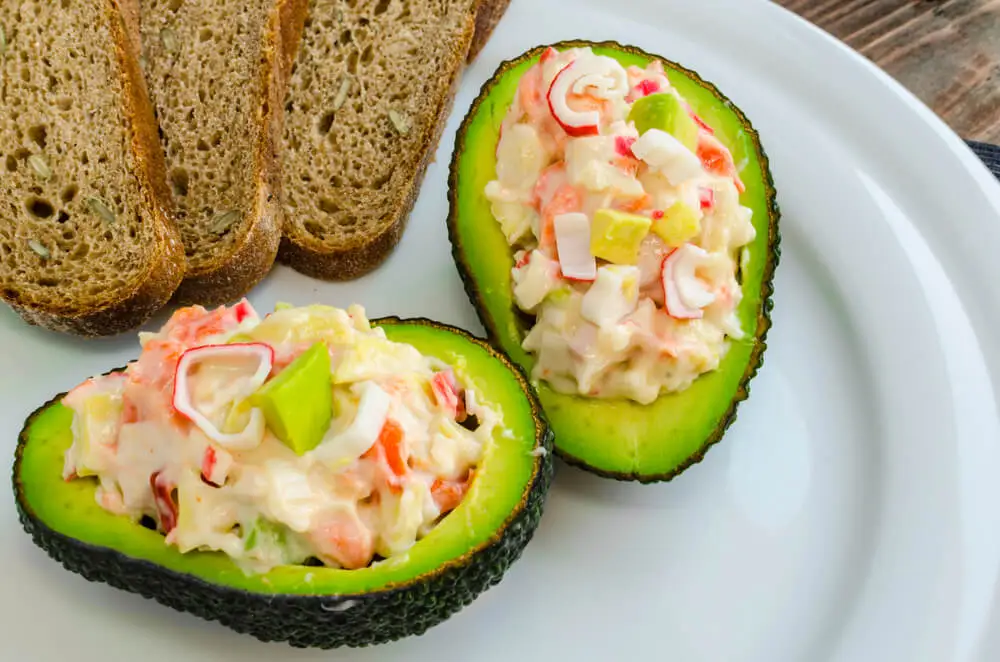Imitation Crab Meat: Do You Know What It's Made Of?


Written and verified by the nutritionist Saúl Sánchez Arias
Imitation crab meat (often called crab sticks) may not be a good product to include in your diet on a regular basis. Despite this, it’s served in many oriental restaurants, since its organoleptic characteristics are good and it’s much cheaper than the original food. However, contrary to what many people think, it isn’t a vegetarian or vegan product, and it has much more carbohydrates than proteins.
Before we start, we must point out that the presence of seafood in the diet is recommended by most nutrition experts, since it’s a low-calorie food with a high nutritional density. They can help cover daily requirements and maintain a good state of health. However, they usually cost quite a lot, and so they aren’t accessible to everyone.
What is imitation crab meat?
First of all, it’s essential to divulge what imitation crab meat is. It’s a product that bears certain similarities to surimi. It’s usually made from different types of fish. Once a thick paste is obtained, starch, flavorings, fillers, and colorings are added to achieve organoleptic characteristics similar to those of crab as such.

However, the nutritional profile is quite different. We’re talking about a product that contains a significant dose of carbohydrates, which are not contained in crab meat as such. It’s true that they’re complex sugars, but they shouldn’t be abused in many types of diets so as not to generate problems related to metabolic health. This is evidenced by research published in the journal Diabetes Research and Clinical Practice.
Among the most commonly used fish for the production of imitation crab, we must highlight haddock. This is a product that doesn’t have much flavor and is readily available. Although it has a high protein content, its fatty acid profile isn’t entirely beneficial. It has few omega-3 fatty acids, which have been shown to be determinant in controlling inflammation in the internal environment.
Get to know more here: Fish Protein: Why It Shouldn’t Be Missing from Your Diet
The nutritional profile of imitation crab meat
From a nutritional point of view, imitation crab meat provides about 80 calories per serving. As for macronutrients, 13 grams correspond to carbohydrates and only 6 grams to proteins. These are of high biological value, but, even so, it’s a very small amount compared to those provided by the seafood as such.
On the other hand, magnesium, vitamin B12, and vitamin B6 stand out. This first vitamin is decisive to avoid anemia over the years. This is demonstrated by a study published in the journal Deutsche Medizinische Wochenschrift. However, it’s present in any food of animal origin. This isn’t the only source.

For comparison, a serving of real crab meat contains about 20 grams (nearly 1 ounce) of protein and many other essential micronutrients. Among the latter, selenium, copper, zinc, iron, niacin, riboflavin, vitamin C, and folate stand out. Therefore, there’s no comparison between these two types of foodstuffs on a nutritional level.
You may also be interested in: The Dangers of Eating Seafood
Can imitation crab meat be harmful?
Generally speaking, imitation crab meat won’t be bad for your health. At least, not in the short term and as long as it’s consumed in moderate amounts. However, it’s necessary to bear in mind that the artificial additives that it contains could slightly alter our internal physiology, if we include them a lot in our diets.
For this reason, it’s always advisable to prioritize the intake of fresh food rather than industrial processed ones. Its nutritional density will be greater and the consumption of chemical compounds that can generate alterations in the function of certain organs will be avoided.
Most of these additives are safe for health, but certain colorings, preservatives, and sweeteners cause a number of controversies within the scientific community nowadays.
Imitation crab meat is a mediocre product
As you have seen, imitation crab meat doesn’t stand out for its high content in proteins, as you would have originally thought. We’re talking about a substitute that has more carbohydrates than other types of nutrients and is made from the remains of fish of below-average quality.
Finally, remember that the presence of fish and seafood in the diet is considered decisive for maintaining a good state of health over the years. However, wild fish should always be given priority over farmed ones because of their better fatty acid profile. This ensures an adequate intake of lipids of the omega 3 series.
All cited sources were thoroughly reviewed by our team to ensure their quality, reliability, currency, and validity. The bibliography of this article was considered reliable and of academic or scientific accuracy.
- Ahola, A. J., Forsblom, C., Harjutsalo, V., Groop, P. H., & FinnDiane Study Group (2019). Dietary carbohydrate intake and cardio-metabolic risk factors in type 1 diabetes. Diabetes research and clinical practice, 155, 107818. https://doi.org/10.1016/j.diabres.2019.107818
- Calder P. C. (2017). Omega-3 fatty acids and inflammatory processes: from molecules to man. Biochemical Society transactions, 45(5), 1105–1115. https://doi.org/10.1042/BST20160474
- Dietzfelbinger, H., & Hubmann, M. (2015). Hämolytische Anämien und Vitamin-B12-Mangel [Hemolytic anemias and vitamin B12 deficieny]. Deutsche medizinische Wochenschrift (1946), 140(17), 1302–1312. https://doi.org/10.1055/s-0041-103562
This text is provided for informational purposes only and does not replace consultation with a professional. If in doubt, consult your specialist.








